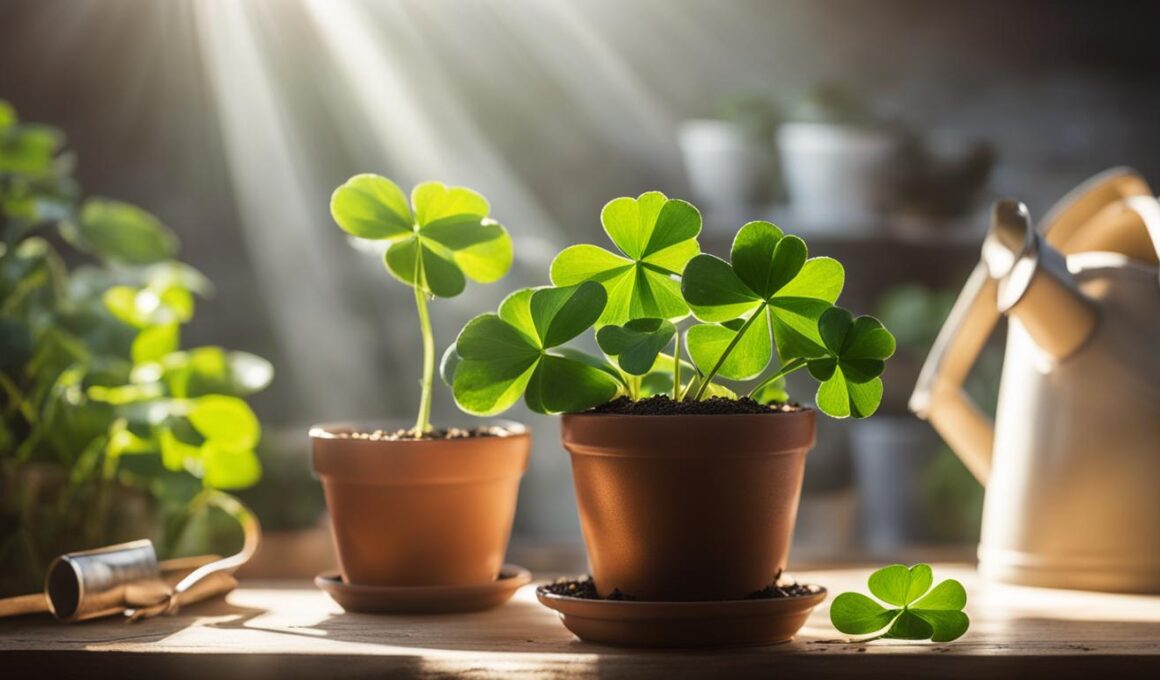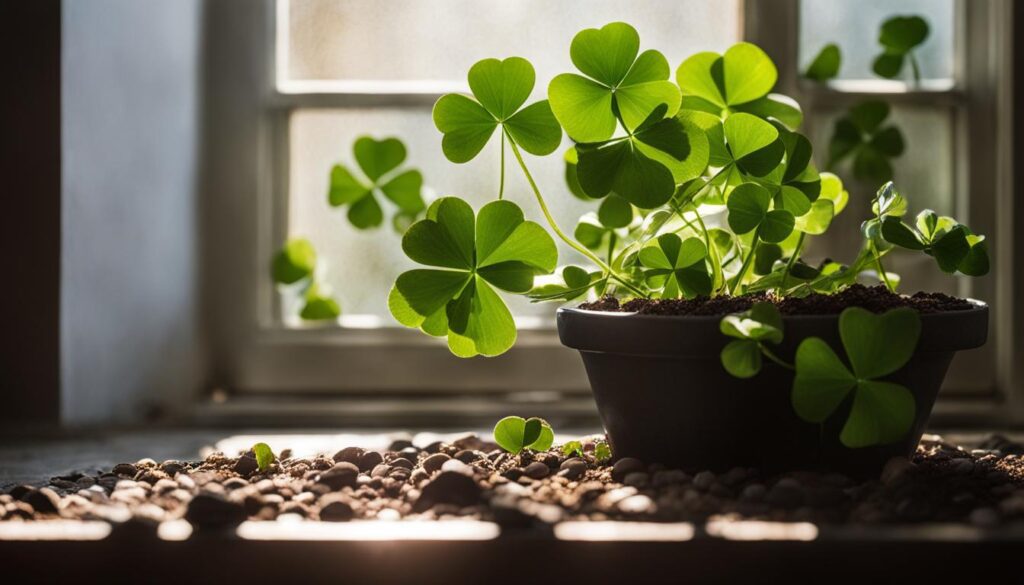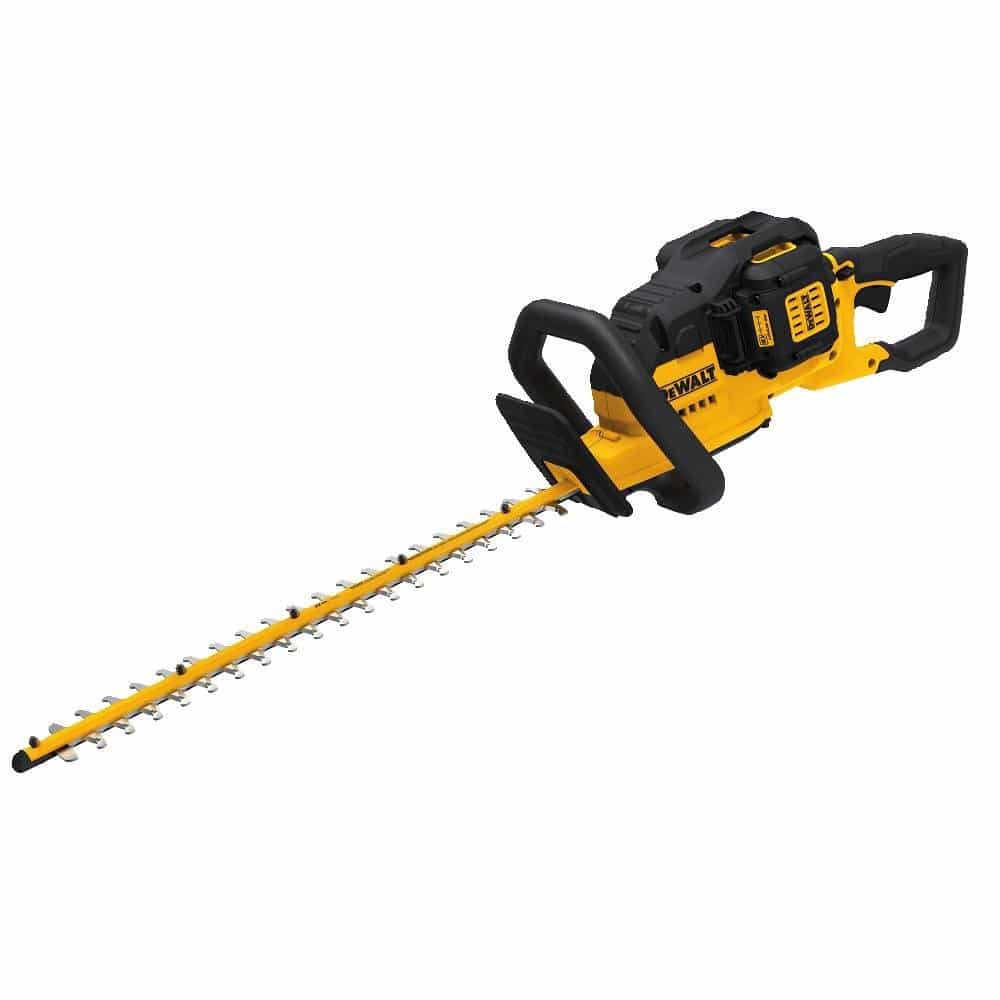The shamrock plant, also known as oxalis or love plant, is a popular choice for indoor gardens due to its beautiful blooms and ease of care. Despite its name, the shamrock plant is not actually related to clover or Irish culture. It derives from the Irish word seamróg, meaning “young clover,” and has become a symbol of Ireland. Caring for shamrock plants is simple, but they do require some specific conditions to thrive. In this section, we will discuss the proper care for shamrock plants, including lighting, soil, watering, temperature, and fertilizer requirements.
Light and Soil Requirements for Shamrock Plants
Proper lighting and soil conditions are essential for the healthy growth of shamrock plants. When it comes to light requirements, shamrock plants thrive in bright, indirect sunlight. They should be placed in a location that receives plenty of natural light throughout the day. However, it’s important to avoid exposing them to excessive direct sunlight, as this can cause leaf scorching.
As for the soil, shamrock plants demand a well-draining, rich, and moist growing medium. An ideal soil mixture would include a combination of peat, perlite, and vermiculite. Adding a small amount of sand to the soil mixture can also aid in improving drainage. It is crucial to ensure that the soil is neither too dry nor waterlogged, as overwatering can lead to root rot.
Light requirements for shamrock plants:
- Bright, indirect sunlight for optimal growth
- Avoid excessive direct sunlight to prevent leaf scorching
Soil requirements for shamrock plants:
- Well-draining, rich, and moist soil
- Use a mixture of peat, perlite, and vermiculite
- Add a small amount of sand to improve drainage
- Avoid excessively dry or waterlogged soil
Watering, Temperature, and Fertilizer for Shamrock Plants
When it comes to caring for your shamrock plants, paying attention to watering, temperature, and fertilization is crucial for their health and vitality.
Watering Shamrock Plants
Proper watering is key to keeping your shamrock plants thriving. It’s important to strike a balance when watering them. Wait until the top inch of soil feels dry to the touch before watering again. However, be cautious not to let the soil dry out completely, as this can lead to stress and damage. Overwatering is one of the most common causes of failure in shamrock plants, so make sure to avoid it.
When watering your shamrock plant, use room temperature water. Avoid using cold or hot water, as extreme temperatures can shock the plant. Stick to lukewarm water to provide optimal conditions for growth.
If you live in a dry indoor environment, you can enhance the humidity around your shamrock plants by using a humidifier or placing a tray of water under the pot. This will help prevent the leaves from drying out and maintain the ideal moisture level.
Temperature for Shamrock Plants
Shamrock plants thrive in moderate temperatures between 60 and 70°F (15 to 21°C). They prefer a climate that mimics their natural habitat. Keep your shamrock plants away from low humidity levels and direct hot sunlight, as these conditions can be detrimental to their growth.
It’s important to provide your shamrock plants with an environment that remains above 50°F (10°C) at the minimum. Avoid exposing them to drafts or sudden temperature fluctuations, as it can cause stress and damage to the plant.
Fertilizer for Shamrock Plants
Fertilizing your shamrock plants is essential to ensure they receive the necessary nutrients for healthy growth. During the growing season, which typically includes spring and summer, fertilize your shamrock plants once a month with a balanced houseplant liquid fertilizer. Make sure to dilute the fertilizer at half strength to avoid over-fertilization.
However, during the dormant seasons, which usually occur in fall and winter, reduce the frequency of fertilization to once every two or three months. Shamrock plants require less nutrients during this time, and over-fertilizing can lead to leaf discoloration and other issues.
Remember, moderation is key when it comes to fertilizing your shamrock plants. Follow the instructions on the fertilizer packaging and avoid excessive application, as it can harm the plant.
By properly caring for your shamrock plants, including providing them with the right amount of water, maintaining suitable temperatures, and fertilizing them appropriately, you can enjoy their vibrant leaves and beautiful blooms for years to come.
Propagation and Repotting of Shamrock Plants
Propagating shamrock plants is a straightforward process that can be done by dividing their rhizomes. To begin, carefully remove the plant from its pot. Gently separate the roots or rhizomes, ensuring you don’t damage them in the process. Next, select fresh, well-draining soil and repot the divided roots or rhizomes. It’s crucial to use a potting mix of high quality, as this will provide the necessary nutrients and good drainage for the plant’s growth.
To maintain healthy shamrock plants, repotting is recommended once every two years. This prevents overcrowding and gives the plant sufficient space to flourish. When repotting, choose a slightly larger pot that has drainage holes to avoid water accumulation and root rot. After repotting, water the plant immediately to help it acclimate to its new environment.
One unique characteristic of shamrock plants is their ability to close their leaves in the evening and reopen them in the morning. This natural process, known as nyctinasty, adds to the plant’s charm and appeal as an indoor plant. By propagating and repotting your shamrock plants, you can ensure their ongoing health and enjoy their beauty for years to come.
Are Shamrock Plants Sensitive to Preen and How Should I Care for Them?
Shamrock plants are not particularly sensitive to preen, but it’s best to avoid using it near them. To care for shamrock plants, ensure they have well-draining soil, moderate sunlight, and consistent moisture. Be mindful of harmful plants for preen, as it may affect the health of your shamrock.










